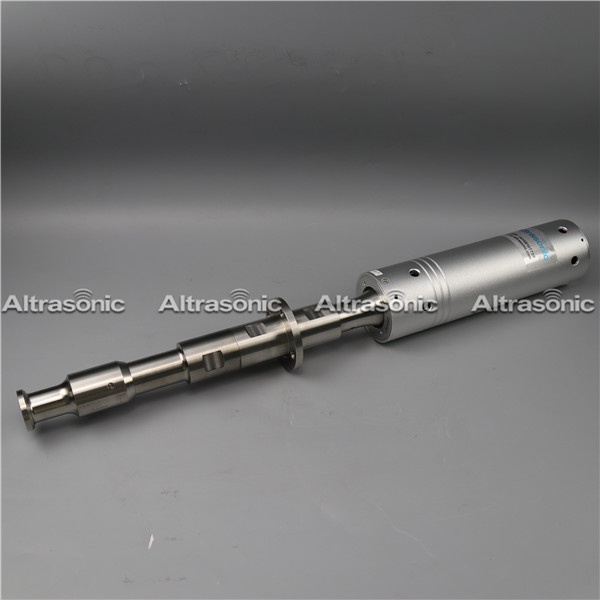
Application for Ultrasonic Homogenizer
Application for Ultrasonic Homogenizer
The application of ultrasonic homogenizer is as follows:
1. Breaking up of cells, bacteria, viruses, spores, fungi, or tissues
2. Extraction of ingredients
3. Homogenization of substances of all kinds
4. Production of the finest emulsions with minimal droplet size
5. Dissolution of hard-to-dissolve and extremely hard-to-dissolve substances in fluids
6. Manufacture of dispersions and suspensions
7. Catalysis and acceleration of chemical reactions
In addition, there are also many special applications in chemistry, biology, and in various technical fields. Thus ultrasonic homogenizers have found increasing importance in cancer research for the preparation of liposomes in recent years. Also the homogenization of cellular suspensions in order to isolate viruses and the removal of proteins from specific structures are examples of medical applications. The potential technical applications are almost infinite, extending from the manufacture of pigments and paints using ultrasonics, to homogenization of waste water, to the breaking up of drill cores from soil samples for purposes of analysis, and determination of grain size in the analysis of minerals.

In SONOCHEMISTRY, applications which accelerate reactions are especially interesting. Thus, for example, the reactivity of metals such as lithium, magnesium, zinc, or aluminum can be increased by removing the oxidized layer from their surfaces by ultrasonic exposure. Ultrasonics also have a catalytic effect in reactions of powders. The catalytic particles are made finer through cavitation, producing a larger reaction surface. The catalytic effect of powdered nickel, for example, is increased by a factor of more than 100.000 when treated with ultrasonic waves. Homogenizers can also be used in forming organometallic complexes, for the destruction of large molecular chains (depolymerization), and for the liquefaction of metal particles in fluids. The rapid localized heating and cooling off through the "cavitation" in fluids caused by ultrasonics also facilitates the splitting of H2O into extremely reactive H+ - and OH- - radicals. Also the "cracking" from alkanes (main components of crude oil) into desired smaller fragments (for example gasoline), which usually occurs at temperatures more than 500 °C, will occur even at room temperature when ultrasonics are used. In the laboratory of the German Red Cross in Berlin, a discovery was made which saves a large amount of time and work in paternity tests by using ultrasonic homogenizers to prepare for the extensive analyses. In this way, a stroma-free hemolysate, a blood solution in which the basic cellular tissue is removed, is produced. Ordinarily the solution must be acted upon by toluol at 4 °C for at least half an hour and the tissue (=stroma) be shaken out manually in toluol. Using an ultrasonic homogenizer, however, the blood solution is simply exposed to ultrasonics a few seconds and the cell structure is mechanically destroyed. Storage and haking out are eliminated, reducing the preparation time from more than 30 minutes to about 5 seconds.
This detailed example indicates some essential aspects of the practical use of ultrasonic homogenizers. Certain substances can be selectively destroyed, time-consuming procedures can radically be simplified, the yield of many reactions is increased, and again and again new uses which have never been thought of occur. Ultrasonic research thus proves to be a fascinating field which again and again confronts the researcher with surprising results. Thus, for example, long molecular chains can be broken up by ultrasonics if they have a sufficiently high molecular weight. Certain macromolecules, however, actually increase in size and complexity if they are exposed to ultrasonics. Polio and other viruses are not changed externally through sonic exposure (i.e. they do not rupture), but surprisingly they can be easily killed in this way. And one last example: Saccharomyces globulus, a yeast, normally does not contain any trace of the enzyme invertase which splits sucrose By using ultrasonics, however, invertase can suddenly be detected (the enzyme was probably present in a chemically inactive form and was awakened from the chemical equivalent to Sleeping Beauty’s slumber). In closing, for the sake of completeness an entirely different application of ultrasonic waves should be mentioned: namely as an aid in the cleaning of objects of all kinds. The cavitation described above also releases microcurrents in the fluid - so-called "jetstreams" - whichare able to remove even the most stubborn dirt from a surface. And since cavitation occurs wherever the ultrasonic waves reach in the fluid, this method is ideally suited for the cleaning of complicated, odd-shaped components which would otherwise be poorly or not at all accessible such as tools, valves, nozzles, assembled subassemblies, solder frames, circuit boards, etc.
© Copyright: 2024 Hangzhou Altrasonic Technology Co.,Ltd All Rights Reserved

IPv6 network supported
Scan to wechat
